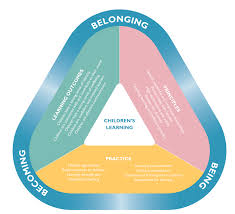Effective pedagogy in the early childhood curriculum is important to the best education outcomes for young children. Te Whaarik, the curriculum document of New Zealand requires teachers having in-depth knowledge of the learner and mediating learning through responsive and reciprocal interactions.
 |
Te Whariki
The early childhood curriculum of New Zealand is called Whaariki, or a mat. You may visualise it as woven from the principles, strands and goals as defined in the curriculum document. The four principles, namely, Empowerment, Holistic Development, Family and Community, and Relationships, are followed by five strands, or essential areas of learning and development. They are Well-being, Belonging, Contribution, Communication and Exploration. Each strand has several goals, and learning outcomes have been developed for each goal. Learning goals are broad and include knowledge, skills, and dispositions.
The principles and strands of Te Whāriki form the framework of the curriculum in early childhood services in New Zealand . Effective pedagogy enables education and care to be integrated, with learning, development, and experiences for children inter-related.
The curriculum explicitly states that it is informed by the perspective of "socially and culturally mediated learning", which highlights the critical role of reciprocal and responsive relationships for children with people, places and things in teaching and learning. Effective pedagogy is linked to children learning through collaboration with adults and peers, through guided participation and observation of others, as well as through individual exploration and reflection.
Responsive and reciprocal relationships require the teacher to understand children’s experiences, interests and "fund of knowledge". To support such understanding, the teacher needs to build linkages between the settings of home and early childhood service, including sharing with families curriculum and learning aims. Within the early childhood setting, reciprocal interactions makes a key contribution to children’s learning and wellbeing. Effective teaching practice is achieved by teachers who are involved, responsive and cognitively demanding, and who encourage “sustained shared thinking” where adults and children co-construct an idea or skill. The pedagogy affirms teachers’ beliefs and assumptions from a credit point of view as the knowledge and skills of families and children are acknowledged and built on.
Te Whaariki does not mention, specifically, any developmental theories. However, it pays tribute to socially and culturally learning, suggesting that learning and teaching is an interplay between the two lines of development - the "natural line" that appreciates construction of knowledge from within the learner, and the "social-historical line" that appreciates the environmental forces (one's culture and background) that influence the child from without.
As regards the "natural line" of development, the curriculum document includes some indicators of broad stages in children's learning and development, and identifies processes of planning, evaluation, and assessment relevant to various stages. The document acknowledges that children make their own discoveries. Under the strand of Exploration, one of the goals is "children experience an environment where their play is valued as meaningful learning and the importance of spontaneous play is recognised." Children learn through play, -" by doing, by asking questions, by interacting with others, by setting up theories or ideas about how things work, and trying them out, and by the purposeful use of resources."
Moreover, the document elaborates on the context of early childhood curriculum with reference to Bronfenbrenner's ecological model. The learner is at the centre, and then it is the child's home, the early childhood education service, and the relationships between these environment, which all have a powerful influence on the child's capacity to learn. The ecological model nicely reinforces the pedagogy of socially mediated teaching practice.
|
 |
Early Years Learning Framework
|
The Australian Early Years learning Framework is generally quite similar to Te whaariki. Interestingly, the EYLF explicitly pays tribute to the discourse of developmentalism. It affirms that play as open-ended, with a child-centred orientation. Play is defined as "providing opportunities for children to learn as they discover, create, improvise and imagine." The pedagogy is informed by the idea that the child and the child's experiences should be the centre of all learning.
At the same time, the EYLF acknowledges a range of theoretical perspectives, including the cultural-historical and post-structuralist movements. Against the background of developmental perspective, the curriculum tries to highlight the role of teachers in child-centred play. While the children are acquiring knowledge themselves through play, the teachers have an important role to play to initiate interactions with children in their play, bearing in mind the learning outcomes, such as desirable knowledge, skills, understanding. Effective interactions help make meaningful connections in which learners refine and reflect on their knowledge and skills. In planning for play-based learning, the role of teacher is to take into account the children's cultural experiences and funds of knowledge. For example, the teacher will connect play activities to particular conceptual and content-based ideas, so the children are able to acquire the desirable content knowledge. Within a play-based framework, the dynamic relationship between children, teachers and content knowledge is affirmed.
To sum up, the EYLF outlines play as a pedagogical practice, informed by a traditional view of the child-centred approach. In addition, it suggests that teachers "provide a balance between child led, child initiated and educator supported learning" through intentional teaching, which is "deliberate, purposeful and thoughtful". With the notion of intentional teaching, the EYLF reconciles the dichotomy of play-based learning and teacher supported learning.
More about pedagogy in coming posts...

